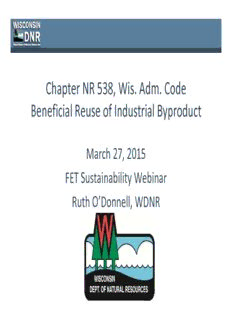
Chapter NR 538, Wis. Adm. Code Beneficial Reuse of Industrial Byproduct PDF
Preview Chapter NR 538, Wis. Adm. Code Beneficial Reuse of Industrial Byproduct
Chapter NR 538, Wis. Adm. Code Beneficial Reuse of Industrial Byproduct March 27, 2015 FET Sustainability Webinar Ruth O’Donnell, WDNR NR 538 QUICK OVERVIEW Established January 1, 1998 Goal = encourage beneficial use of industrial byproducts in a nuisance‐free and environmentally sound manner http://www.we-energies.com/environmental/CoalCombustionProducts_2K11018.pdf WISCONSIN INDUSTRIAL BYPRODUCTS 2000 – 2013 29.5 million yd3 s available d r a y c i b u 19.6 million yd3 c n used o i l l i M NR 538.03(4) Specific high‐volume industrial byproducts: paper mill sludge, coal ash, flue gas desulfurization material, foundry sand & slag, lime kiln dust, Other non‐hazardous solid waste with similar characteristics Creates 5 categories of industrial byproducts Specific uses are allowed for each category Industrial Byproducts RCRA non‐hazardous Category (1‐5) assigned based on lab analysis ASTM Water Leach Test mg/L Total Elemental Analysis mg/kg Potential risk to human health & the environment Category 1 = few restrictions on use Category 5 = most restrictions on use & placement Category standards based on: NR 140 (drinking water) NR 105 (surface water quality) NR 720 (soil cleanup) Industrial Byproduct Beneficial Uses Projects Category NR 538, Appendix I NR 538.10 5 4 3 2 1 Table 4 x x x x x (1) Raw Material for Manufacturing a Product (2) Waste Stabilization / Solidification x x x x x (3) Supplemental Fuel Source / Energy Recovery x x x x x (4) Landfill Daily Cover / Internal Structures at landfills having a leachate x x x x x collection system (5) Confined Geotechnical Fill *Byproducts and uses (a) commercial, industrial or institutional building subbase need to meet structural (b) paved lot base, subbase& subgrade fill (c ) paved roadway base, subbase& subgrade fill and physical specifications (d) utility trench backfill (e) bridge abutment backfill and generally accepted (f) tank, vault or tunnel abandonment x x x x (g) slabjackingmaterial engineering practices for (h) soil and pavement base stabilization for structural improvements listed in (5)(a) -(c) the use. (i) controlled low strength material (flowable) fill for structural improvements listed in (5)(a), (d), (e) and (f) Obligated to meet all (6) Encapsulated Transportation Facility Embankment x x x x other Federal, State & (7) Capped Transportation Facility Embankment Local permits, zoning and x x x regulatory requirements (8) Unconfined Geotechnical Fill x x x that may apply. (9) UnbondedSurface Course x x (10) Bonded Surface Course x x (11) Bonded Surface Course (Federal, state or municipal roadways) x x x (12) Decorative Stone x x (13) Cold Weather Abrasive X x Regulatory Requirement Overview* Initial & annual reporting Industrial byproduct testing Storage & transportation requirements Project‐specific specifications Placement restrictions Public participation process for large projects Submittal of notification to DNR requesting project concurrence required with some projects Property owner notification Environmental monitoring – large volume DOT embankment projects * see code for all requirements Coal Combustion Residuals Bottom Ash – coarse to fine‐grain, sand‐like Structural fills, road bases and sub-bases, aggregate for concrete, asphalt and masonry, Fly Ash – fine powder, silt, cementitious SiO +Al O +Fe O 2 2 3 2 3 Concrete, structural fills, asphalt, soil stabilization Flue gas desulfurization gypsum ‐ CaSO 4 Agricultural soil amendment*, source of plant nutrients Ca & S, wallboard, cement manufacturing and concrete production *as allowed by NR 538.08(7) Foundry Byproducts Spent sand from mold process Geotechnical & structural fills, paved roadway base, sub-base, embankments Slag Cement manufacturing, aggregate replacement Category 2 Paper Mill Byproduct Pulping sludge used as raw material to make “soil”* *as allowed by NR 538.08(7) Used in mine reclamation, on landfills for fill purposes or to establish rooting zone for final grass cover
Description: